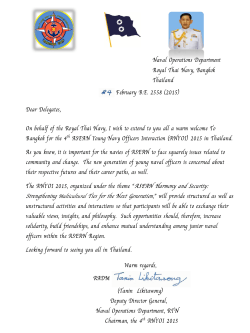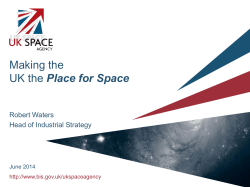
Neptune Software Introduction - Ground System Architectures
Neptune Software Introduction Jeffery Cleveland Neptune Software Program Manager cleveland@nrl.navy.mil (202) 404-7100 Brian Cassidy Neptune Software Deputy PM brian.cassidy@nrl.navy.mil (202) 767-5094 TRADEMARK NOTICE: Neptune® and Common Ground Architecture® are registered trademarks of the United States Navy. CGA™ is a trademark of the United States Navy. UNCLASSIFIED Naval Research Laboratory Washington D.C. Naval Research Lab (NRL) Satellite Ground System Implementation Mission Operations Center (MOC) Satellite Operations Center (SOC) • Web-based mission planning system • Provides: • User requests • Satellite modeling • Tasking • scheduling • Maneuver planning • Government owned • C2 software used for satellite development, integration & test (I&T), launch, and operations • Government owned Ground Station(s) • • • • • Digital → RF (commanding) RF → Digital (telemetry) Shared antennas “Lights Out” Automation Data Distribution Data Processing • Mission specific implementation NRL Blossom Point Tracking Facility (BPTF) VMOC, Neptune software, and Blossom Point provide integrated and capable satellite operations 2015Neptune_Software 2 UNCLASSIFIED Naval Research Laboratory Washington D.C. Neptune Software Overview • NRL Neptune software is a multi-mission command and control (C2) suite that meets the following broad requirements: – Provide C2 for any number of satellite programs using a common code base – Provide control and status for all ground hardware required to support the missions – Support all mission phases (box-level testing through operations) – Automate everything possible to increase reliability and reduce Autonomous Operations human errors Telemetry Commanding Resource Management 2015Neptune_Software 3 Control Language UNCLASSIFIED Data Recording & Analysis Application Development Human / Machine Interface Naval Research Laboratory Washington D.C. Experience and History of Success SENSE – 2013 • 30+ years of satellite integration, test, and operations • Code base continually modernized – Code originally written in Fortran under VMS – Rewritten to C under Solaris – Ported to Linux operating system using C/C++/Java in mid-2000s – Current conversion project from 32-bit to 64-bit to take advantage of hardware advances and meet future OS and 3rd party requirements WindSat (Coriolis) – 2012 Colony I cubesats– 2010 RPP – 2011 TacSat-4 – 2009 TIE Payload – 2006 TiPS – 1998 Selected Neptune software supported missions: Clementine (DSPSE) – 1994 Living Plume Shield (LIPS) – 1980s Multiple Satellite Dispenser (MSD) – 1970s 2015Neptune_Software 4 TacSat-1 – 2003 ICM – 1995 LACE – 1989 UNCLASSIFIED Naval Research Laboratory Washington D.C. Four Important Concepts Government-Off-The-Shelf (GOTS) Single Baseline • Neptune software is managed by NRL • NRL owns the source code and holds unrestricted rights to software • NRL provides Neptune software development and sustainment on cost reimbursable basis • Applied across all sites and program phases • Users share development & sustainment costs • Reliability and stability promoted by supporting diverse missions Multi-Mission Automation • Designed from the ground up as a true multimission, site configurable C2 package • Separation of mission unique from core software maximizes reuse and cost savings • Users define their CONOPS • Pre-defined operator tasks are scripted into software by site engineers • Tunable from no automation to full ‘lights out’ • Hundreds of daily contacts for many missions can be reliably and cost-effectively operated by minimal staff TacSat-1 Argos TacSat-4 CubeSat Colony I, II TacSat-2 RPP WindSat SENSE 2015Neptune_Software 5 UNCLASSIFIED Naval Research Laboratory Washington D.C. Single Baseline • Neptune software users fund development and sustainment through the single baseline concept NRL User A User B User N User Inputs: - Defect reports - Enhancement requests - Cybersecurity requirements Shared Neptune Development NRL 2015Neptune_Software 6 User A User B UNCLASSIFIED Single Baseline Release: - Defect fixes - Enhancements - Cybersecurity improvements User N Naval Research Laboratory Washington D.C. Multi-Mission • Neptune software supports multiple satellites at same SOC • Software development distributed to most knowledgeable and costeffective engineers Local Satellite/Ground Engineers • Displays • Databases • Automation • Scripts NRL/Local Software Engineers • Command and telemetry code modifications • Hardware drivers User User Extensions Configurable Extensions MissionUnique Unique Mission Software(MUS) (MUS) Software NRL Software Engineers • Common C2 functions • New capability development • Support user CONOPS 2015Neptune_Software 7 Reused Software Core UNCLASSIFIED Naval Research Laboratory Washington D.C. Summary • Neptune software has a history of success supporting diverse missions – GOTS derives from government ownership and management of the code – Single baseline to share development and sustainment – Multi-mission architecture to reuse core software and allow users to configure system – Automation to increase reliability, resiliency, and decrease costs • Programs using the Neptune software realize many benefits – Software stability – Lower, more predictable costs for individual programs – Advanced capabilities based on requirements from multiple users 2015Neptune_Software 8 UNCLASSIFIED Naval Research Laboratory Washington D.C. Backup 2015Neptune_Software 9 UNCLASSIFIED Naval Research Laboratory Washington D.C. Government Off-The-Shelf • NRL developed most cost-effective solution for multiple internal programs • NRL experienced in developing and configuring Neptune software for external users Mission • Flexible funding mechanisms for users Requirements • Local user participation encouraged Systems Engineering 4% 10% Mission Unique 80% Reusable Code 10% Ground Unique Delivered System 2015Neptune_Software 10 UNCLASSIFIED Naval Research Laboratory Washington D.C. Automation • Acts as the ideal operator – Only follows pre-defined and approved scripts – Same inputs → same conclusion • Monitors spacecraft telemetry and ground site status – When anomalous values detected, follows pre-approved procedures • Additionally monitors computer processes, networks, and facility alarms (temperature, fire, power, etc.) • Local satellite/mission engineers develop, control, and use the automation • Operating “lights out” at NRL’s BPTF since 2007 – – – – – Hundreds of thousands of contacts executed Staffing reduced to satellite engineers working business hours Increased reliability and resilience Decreased cost 2015Neptune_Software 11 UNCLASSIFIED Naval Research Laboratory Washington D.C. Neptune SOC2SOC Shares Ground Station Resources “Develop DOD-wide guidance, specific to space systems, to allow for the integration and consolidation, to the extent feasible, of DOD’s current and future satellite ground control systems via common ground architecture or by other similar means” – GAO-10-55 p. 25 • Users establish CONOPS/priorities and configure Neptune software databases • SOC2SOC enables antenna sharing between ground stations providing users additional satellite contacts during equipment idle time • Hybrid solution of “sharing” the various dedicated antenna systems • Operating successfully on the SENSE satellite program since 2013 2015Neptune_Software 12 UNCLASSIFIED Naval Research Laboratory Washington D.C. External Evaluations • Neptune software is “a highly attractive and accessible architecture” that “makes effective use of automated ground operations” and “incorporates key characteristics that could benefit microsats” – USAF Scientific Advisory Board Report on Microsatellite Mission Applications p. xii • “One satellite control facility operated by the Navy, known as Blossom Point, does operate a ground system that can control a variety of national security satellites. The facility uses a common approach (architecture) to command and control the satellites as well as receive and analyze data and information transmitted from the satellites. The common approach allows the facility to reuse a large percentage of the existing software across multiple satellites” – GAO-10-55 p. 23 • Neptune software is “a proven product” that “has been successfully used for a number of years to support NRL missions, other Government S&T missions, other Government residual missions, and commercial missions” – Aerospace report TOR2014-00448 p. 54 2015Neptune_Software 13 UNCLASSIFIED Naval Research Laboratory Washington D.C.
© Copyright 2025









